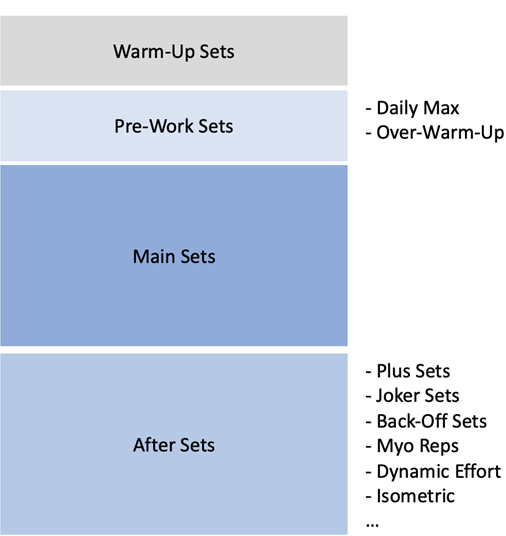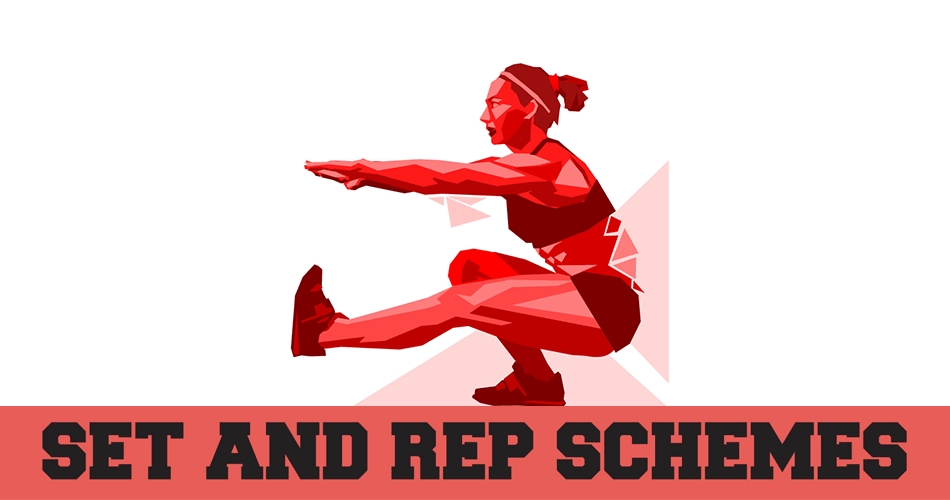Strength Training Manual: Planning – Part 3
1. Introduction
2. Agile Periodization and Philosophy of Training
3. Exercises – Part 1 | Part 2
4. Prescription – Part 1 | Part 2 | Part 3
5. Planning – Part 1 | Part 2 | Part 3 | Part 4 | Part 5 | Part 6
I am very happy to announce that I am finishing the Strength Training Manual. I decided to publish chapters here on Complementary Training as blog posts for two reasons. First, I want to give members early access to the material. And second, this way I can gain feedback and correct it if needed before publishing it.
I look forward to hearing your thoughts.
Enjoy reading!
Previous chapter introduced theoretical concepts behind planning, using the dose-response “Small Worlds” and multiple complementary aspects of planning, culminating with the concepts of pull the floor and push the ceiling. In this chapter, these will be put into more concrete and pragmatic form for strength training.
The building block of this chapter will be set and rep schemes, that together with exercise (or mean) represent a prescription unit (Figure 5.26), or the smallest planning unit (i.e., strength training atom).

Figure 5.26. Prescription unit consists of exercises and set and rep schemes
Set and Rep Schemes: The Basis
Chapter 3 covered exercises and their classification. This chapter will delve more into set and rep schemes and combinatorics used in planning (e.g., vertical and horizontal planning as well as divisible and indivisible strategies and other novel planning strategies that will be discussed shortly). Before we even start with more advanced topics, let’s cover the anatomy of a set and rep scheme.
Anatomy of a set and rep scheme
Figure 5.26 contains anatomy of a set and rep scheme. This is of course a simplification (“Small World”), but quite frequent and useful model. Every set and rep scheme consists of multiple components (i.e., sets), but what you find in most if not all strength training material are the main sets. This is unfortunate, since set and rep scheme is much more complex and richer construct.

Figure 5.27. Anatomy of a set and rep scheme
Warm-up sets
Similarly to the discussion on active recovery means and methods in the previous chapter, I approach warm-ups differently. Rather than looking at warm-up as means to reach working temperature of the body and priming the nervous system only, one can look at warm-ups as affordance to practice and develop particular quality at the current state of the organism or athlete. I know this is a mouthful, but it simply means addressing what can be addressed while athlete is warming up. During the warm-up one can perform and address different qualities that can be addressed at that particular state. For example, one might perform Vanilla training like rehab, mobility, pre-hab, core, stabilization and so forth, as well as practice the main movement.
This is particularly useful in the beginning of the workout, where a given exercise is performed first. The warm-up part of the workout can be blended with the main part of the workout through warm-ups sets of the first exercise. Let’s take bench press as an example, where 5×5 at 75% is planned as the main sets.
Address qualities that need to be addressed in this state of the organism
- Foam Roll and Breathing drills if needed (e.g., someone coming after work through city rush hour)
- Ground Mobility
- Core
- Kettlebell or Bodyweight Circuit/Complexes
Bench Press 5×5 @75% (main sets)
Warm-up sets
- Empty bar x 10 reps
- Band pull-a-parts x 10 + Lat Stretch with band
- Bench Press 30-40% x 5, start with isoHold at the chest and work on the tightness in the bottom position
- Thoracic stretch + Face Pulls
- Bench Press 40-50% x 5
- Hip flexor stretch if needed + YTWLs for the shoulder
- Bench Press 50-60% x 5
- Any extra mobility/core exercises or even explosive push-ups
Main sets…
The example above is a nice transition from the warm-up part to the first exercise, rather than the abrupt switch. The warm-up sets, particularly for the first exercises in a workout can serve as an opportunity to address other qualities and nagging issues (i.e., weaknesses), as well as practice the quality of execution (or even variable execution, e.g. using different grip lengths, tempos, pauses, depth and so forth) of the main movement.
More complex movements, like Olympic lifting might ask for longer ramp-up to the working sets and adding extra elements in (e.g. mobility, etc). Warm-up sets can also serve as a way to check if everything is fine and adjust the main set accordingly. For example, I pretty much know what I can expect of the workout once I pinch the 20kg plates when loading the bar (pun intended). Other methods might involve estimating 1RM using VBT approach (e.g., using 40-60-80% 1RM and using linear regression to estimate load at particular velocity at 1RM; see previous chapter for more info). Sometimes one feels like crap, but once the warm-up is finished, some magical energy appears and everything is up and running. The opposite can happen too – one feels very good before a workout, but during the warm-up few issues emerge and demand pivoting in the main sets or changing the exercise or workout altogether (e.g., discovering a weird pinch in the shoulder, and deciding to use Swiss bar or dumbbells rather than straight bar for the bench press). For this reason, warm-up sets are very important and insightful. Use them for more than just banging few reps to warm-up – use them as a probing process and adjust accordingly.
Warm-up sets can be much shorter and without any extras for the later exercises, since the athlete is warmed-up. But again, this depends on the exercises that follow. For example, if squats follow this bench press exercise, additional lower body warm-up might be needed.
There are multiple ways to ramp warm-up sets towards working/main sets, but it usually involves doing either higher reps at the lower percentages or not. For example:
50% x 8
60% x 6
While it is important to warm-up and practice technique, it is also important not to create unnecessary fatigue with the warm-up sets. For this reason, it might be wise to keep the reps low (i.e. under 6) and with a lot of RIR. Thus, you should not pursue the “burn” with warm-up sets at 40-60% by doing 10-20 reps. That is just dumb. Everything else, including jumps and number of warm-up sets is individual preference.
Also note that some athletes prefer longer warm-ups, and some are ready to roll the instant they step into the gym. This could be genuine preference or the body need, or it could be a simple habit. It is thus possible to experiment with extending or shortening the warm-ups. I personally prefer longer smoother warm-ups and I generally take longer to warm up. Friend of mine and coach of the Female Volleyball Serbian National Team, Vanja Bankovic, noticed that some athletes in the jump test need more jumps to reach their maximal height, while some do it on the first rep. It could be different CNS or whatever, but the point is that athletes differ. One can try to change the athlete or to adapt to the athlete of course. I just love the guys who say “Have you ever seen a lion warming up before hunting a gazelle?”. I tend to answer with a counter question “Have you ever seen a lion sitting at a desk in the office for 10 hours? Me neither”. Don’t be a dogmatic idiot – adapt the athlete, but also adapt to the athlete. It is a complementary pair.
Also note that warm-up sets are not counted in the dose – response models. But as has been seen, they represent fruitful component of the training session and the prescription unit, that is often missed in “Evidence-Based” lab coat models.
Pre-work sets
This part of the set and rep scheme is usually completely neglected. The first time I’ve heard about this concept was in the excellent “Base Building” book by Paul Carter (Carter, 2013), where he suggested using Over Warm Ups. Over warm-ups represent warming-up past the weight you plan using for your main sets. In the above example of 5×5 @75% that might involve the following
40% x 5
50% x 5
60% x 3
70% x 1
80% x 1
75% x 5 x 5
Here 80% x 1 represent over warm up set. Not sure if you noticed, but without over warm up, first set @75% feels a bit weird, but later sets are much better. To avoid this, and to prime for the main sets, over warm up sets can be used. This is usually 5-10% higher than the working sets, but it can actually be working up to you EDM or daily-max without too much expectation and emotional fuss. This max can be used to calculate working weights (e.g., 75% of daily max, rather than the pre-cycle 1RM).
40% x 5
50% x 5
60% x 3
70% x 1
80% x 1
90% x 1
100+ x 1 (find out daily-max)
75% of daily max for 5 x 5
This represents more advanced methodology, although it takes the problem of figuring out the EDM out of equation, as well as adjusting for individual rate-of-change and day-to-day fluctuation. It is powerful, but it is also a double-edged sword, because to use it frequently one needs to learn to be relaxed and not pushing it, without emotional drain and drama. Add to this multiple exercises that this needs to be done for. Thus, this is easier said than done, particularly on the bad days when daily-max might go down.
Pre-work sets might involve using overcoming isometrics (isoPush), or explosive movements as well (explosive push-ups were performed before the last warm-up set in the warm-up sets example).
40% x 5
50% x 5
60% x 3
70% x 1 + isoPush 6sec
80% x 1 + explosive Push ups x6 reps
75% for 5 x 5
Additional pre-work technique that can be used are walk-outs and holds and these can be over 1RM. This is particularly useful if the working sets are 90%+. These involve using very heavy weight and just holding it in the racking position or walking out with it. Not sure this would be something to use frequently, but represents viable strategy if used sparingly and smartly.
I think pre-work sets are a hidden gem, and I am more than thankful to Paul Carter for pointing us to it. Used sparingly and wisely they represent powerful tool.
Main or Working sets
These are bread-and-butter of the set and rep scheme. As such, they are considered in greater depth in this chapter and I won’t delve much in them here. For the sake of completeness, Figure 5.28 consists of common prescription formats when it comes to set and rep schemes, particularly main sets.

Figure 5.28. Common examples of the prescription format of the set and rep schemes
After sets
After sets represent additional opportunity and affordance in the workout and there are different implementations here. Let’s cover the most common:
Plus sets. Plus sets involve finishing main sets with a set to failure (or to a particular ceiling, e.g., 10 reps max). Here is an example:
75% x 5
75% x 5
75% x 5
75% x 5+
The last set is a plus set, where athlete tries to lift as many quality (in the same manner previous sets and reps are prescribed) reps as possible (hopefully without too much mental strain and psyching up). This can be used as an embedded test (see reps to technical failure in Chapter 4) and estimate of 1RM. Performance on the plus set can then be used as a source of information for updating 1RM/EDM to base percentages off for the next training phase. More about this will be covered in Chapter 6.
Joker Sets. These are suggested by Jim Wendler of the 5/3/1 fame (Wendler & Koss, 2013; Wendler, 2017), and they involve adding few sets +5% or more after the main sets. There are multiple ways to do this. For example, if one feels good after the main sets, add a set or two with extra 5% added to your working sets
75% x 5
75% x 5
75% x 5
75% x 5
80% x 5
85% x 3 (failed)
Another approach might be to continue doing singles to your daily max (which might be decreased due to fatigue from the main sets):
75% x 5
75% x 5
75% x 5
75% x 5
80% x 1
85% x 1
90% x 1
95% x 1
100% x 1
Back-Off sets. These represent a plethora of methods to increase the volume (dose) of the workout. Usually this is done by decreasing top set % for 10-20% and continue performing either same or increased number of reps compared to working sets:
Option #1: 65% x 5 reps x 3 sets
Option #2: 65% x 10 reps x 3 sets
Option #3: 65% x max reps
Jim Wendler, in 5/3/1, uses First Set Last (FSL) option, or Second Set Last (SSL) option to create more volume (Wendler & Koss, 2013; Wendler, 2017). Both of these represent variation of the back-off sets. Back-off sets, particularly if lighter and with higher RIR can be used to really pound the technique (e.g., see dynamic effort and isometric below). Or they can be used to inflict more training dose.
There are few bodybuilding methods that could be used here, such as strip sets, forced reps, cheating, burns, negatives and so forth.
Myo-Reps. Another method that could be useful here is Myo-Reps 1 or other rest-pause technique to acquire more volume of work. This can be done with the same weight, or reduced weight.
Option #1: 75% x 6 + 2 + 2 + 1
Option #2: 65% x 10 + 4 + 4 + 3
Dynamic-effort. One can reduce the weight to 40-70% and performs sets for 1-3 as fast as possible in the aftermath of the work sets.
70% x 8 sets of 3 reps
Isometrics. Sometimes one can finish working sets using few sets with reduced weight by implementing isometric holds. This is a great way to train and to finish with great technique.
50% x Hold 10-20sec in the bottom x 2-3 sets
Variations. All the above after sets are performed with the same exercise (i.e., bench press in this example). Jim Wendler sometimes utilizes supplement lifts for the back-off sets (Wendler & Koss, 2013; Wendler, 2017). For example after 5×5 @75% for bench press, one can do back off sets 3×10 @65% using incline dumbbell press or ring push-ups. This can be useful to avoid chronic overload syndrome but also to introduce variability in training. For example, the back-off sets could be done by using different exercises within the same movement bracket, different tempos (slow eccentrics, long holds, etc), using different grip widths (or even bands and chains) with the dynamic effort, using shortened or extended range of movement and so forth. It can also mean involving some play, fun and exploration elements once the main sets are done (which can be considered work). For example, one might say to the athletes “Once you finish the prescribed, you can select another exercise from this exercise pool and do a few extra sets”. This can increase feelings of being in control and the fun element, which is not to be disregarded (and often is in the lab coat models).
With team sport athletes, who can be competing frequently, changing exercises from phases to phase represents a particular risk of soreness due to novel exercises (but it might be needed to avoid boredom and chronic overload syndrome). This can be alleviated by introducing the next phase main movements in the after-sets. For example, after 3×5 of the back squat, one can do a few easy sets of the front squat that we plan emphasizing in the next training phase. This way, one will be prepared technically for the next phase, but also avoid potential downside due to soreness and heavy legs.
Between these sets, the warm-up sets of the next exercise in the workout can be performed. For example, if the next exercise is squat, after 5×5 @75% bench press, during drop-off sets one can inject few goblet squats, empty bar squat and maybe a set with some weight. This depends on the logistics in the gym and equipment constraints of course, but it is viable strategy to save time.
Kitchen Sink. One can of course combine all of the above in the workout. Here is an example
4×5 @75% (Working sets)
1×5+ @75% (Plus set)
85% x 3, 95% x 1 (Joker set)
DB Bench Press (change flat, incline, decline on every set)
3×8-12 @60-70% (Back Off sets & Variability)
Organization of exercises in the workout
As already explained, the elementary unit of the strength training program is a prescription unit (Figure 5.26) that consists of an exercise and a set and rep scheme. One workout has multiple of those, which should be somehow organized (see Chapter 3 for more discussion on the topic). Let’s assume the following exercises (i.e., prescription units) are to be performed in a workout:











Responses